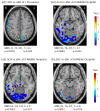Signal Variability and Cognitive Function in Older Long-Term Survivors of Breast Cancer with Exposure to Chemotherapy: A Prospective Longitudinal Resting-State fMRI Study
- PMID: 36291217
- PMCID: PMC9599386
- DOI: 10.3390/brainsci12101283
Signal Variability and Cognitive Function in Older Long-Term Survivors of Breast Cancer with Exposure to Chemotherapy: A Prospective Longitudinal Resting-State fMRI Study
Abstract
The purpose of this study was to assess the effect of chemotherapy on brain functional resting-state signal variability and cognitive function in older long-term survivors of breast cancer. This prospective longitudinal study enrolled women age ≥ 65 years of age who were breast cancer survivors after exposure to chemotherapy (CH), age-matched survivors not exposed to chemotherapy, and healthy controls. Participants completed resting-state functional brain MRI and neurocognitive testing upon enrollment (timepoint 1, TP1) and again two years later (timepoint 2, TP2). There were 20 participants in each of the three groups at TP1. The CH group showed a significant decrease in SDBOLD (blood-oxygen-level-dependent signal variability in standard deviation) in the right middle occipital gyrus (ΔSDBOLD = -0.0018, p = 0.0085, q (pFDR) = 0.043 at MNI (42, -76, 17)) and right middle temporal gyrus (ΔSDBOLD = -0.0021, p = 0.0006, q (pFDR) = 0.001 at MNI (63, -39, -12)). There were negative correlations between the crystallized composite scores and SDBOLD values at the right inferior occipital gyrus (correlation coefficient r = -0.84, p = 0.001, q (pFDR) = 0.016) and right middle temporal gyrus (r = -0.88, p = 0.000, q (pFDR) = 0.017) for the CH group at TP1. SDBOLD could be a potentially useful neuroimaging marker for older long-term survivors of breast cancer with exposure to chemotherapy.
Keywords: blood-oxygen-level-dependent (BOLD) signal variability; breast cancer; cancer-related cognitive impairment; chemotherapy; resting-state fMRI.
Conflict of interest statement
All authors declare that they have no conflict of interests.
Figures



Similar articles
-
Intrinsic brain activity changes associated with adjuvant chemotherapy in older women with breast cancer: a pilot longitudinal study.Breast Cancer Res Treat. 2019 Jul;176(1):181-189. doi: 10.1007/s10549-019-05230-y. Epub 2019 Apr 13. Breast Cancer Res Treat. 2019. PMID: 30989462 Free PMC article.
-
Altered gyrification in chemotherapy-treated older long-term breast cancer survivors.Res Sq [Preprint]. 2023 Apr 10:rs.3.rs-2697378. doi: 10.21203/rs.3.rs-2697378/v1. Res Sq. 2023. Update in: Brain Behav. 2024 Aug;14(8):e3634. doi: 10.1002/brb3.3634. PMID: 37090667 Free PMC article. Updated. Preprint.
-
Cortical thinning in chemotherapy-treated older long-term breast cancer survivors.Brain Imaging Behav. 2023 Feb;17(1):66-76. doi: 10.1007/s11682-022-00743-5. Epub 2022 Nov 11. Brain Imaging Behav. 2023. PMID: 36369620 Free PMC article.
-
Altered gyrification in chemotherapy-treated older long-term breast cancer survivors.Brain Behav. 2024 Aug;14(8):e3634. doi: 10.1002/brb3.3634. Brain Behav. 2024. PMID: 39169605 Free PMC article.
-
Resting State BOLD Variability in Alzheimer's Disease: A Marker of Cognitive Decline or Cerebrovascular Status?Front Aging Neurosci. 2018 Feb 21;10:39. doi: 10.3389/fnagi.2018.00039. eCollection 2018. Front Aging Neurosci. 2018. PMID: 29515434 Free PMC article.
Cited by
-
MRI Voxel Morphometry Shows Brain Volume Changes in Breast Cancer Survivors: Implications for Treatment.Pathophysiology. 2025 Mar 12;32(1):11. doi: 10.3390/pathophysiology32010011. Pathophysiology. 2025. PMID: 40137468 Free PMC article.
-
An Activation Likelihood Estimation Meta-Analysis of Voxel-Based Morphometry Studies of Chemotherapy-Related Brain Volume Changes in Breast Cancer.Cancers (Basel). 2025 May 16;17(10):1684. doi: 10.3390/cancers17101684. Cancers (Basel). 2025. PMID: 40427181 Free PMC article.
References
-
- Muss H.B., Berry D.A., Cirrincione C., Budman D.R., Henderson I.C., Citron M.L., Norton L., Winer E.P., Hudis C.A. Toxicity of older and younger patients treated with adjuvant chemotherapy for node-positive breast cancer: The Cancer and Leukemia Group B Experience. J. Clin. Oncol. 2007;25:3699–3704. doi: 10.1200/JCO.2007.10.9710. - DOI - PubMed
-
- Crivellari D., Bonetti M., Castiglione-Gertsch M., Gelber R.D., Rudenstam C.M., Thürlimann B., Price K.N., Coates A.S., Hürny C., Bernhard J., et al. Burdens and benefits of adjuvant cyclophosphamide, methotrexate, and fluorouracil and tamoxifen for elderly patients with breast cancer: The International Breast Cancer Study Group Trial VII. J. Clin. Oncol. 2000;18:1412–1422. doi: 10.1200/JCO.2000.18.7.1412. - DOI - PubMed
Grants and funding
LinkOut - more resources
Full Text Sources

